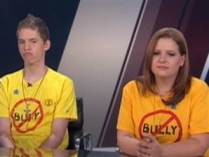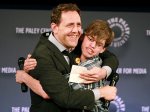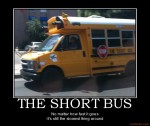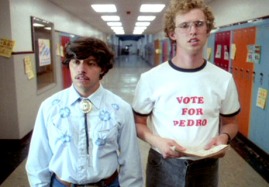
Jackie Libby recalls that she and her husband, once found their son Alex passed out in the front yard of their Sioux City home.
“He said some boys were slamming his head into a seat on the bus,” Jackie said. “We thought he made it up.”
I keep seeing commercials for The Bully Project. So I’m starting to pay attention. I watched an interview with Alex Libby, one of the 5 kids who were followed for a year in this important documentary. The stories of these kids are heart-breaking, and include two children who committed suicide after prolonged bullying.
Something about Alex made me watch more carefully — does he have some form of autism? They don’t mention it – but I spot a blue puzzle pin near his shoulder, and when I look closely his mom is wearing one too. I check the promotional website but Alex’s bio doesn’t mention Autism. I wonder why.

Alex Libby and his mom Jackie during a TV interview about the movie release http://thebullyproject.com/indexflash.html
Digging deeper, I find an explanation from the film-maker, Lee Hirsch: “…both Tyler Long and Alex have Asperger’s Syndrome, and we made a conscious decision not to disclose that in the film. We certainly could have, and perhaps it would have been insightful to the audience and we talked about it a lot. Ultimately, we decided that we didn’t want anything to make the audience think, Oh, well, that explains it. Well, of course. We didn’t want anything that anyone could hang onto in that way.”
Wow. That explains it? Well of course? Like, they have Asperger’s syndrome, so of course they’re going to be bullied?
A variety of kids are targeted by bullies, not just kids with autism. Gay kids are beaten up. Kids with learning disabilities and mental health diagnoses are called names. Kids who are perceived as weak and non-assertive are intimidated. Kids who are different are at risk of being bullied in so many different ways. But somehow, Alex’s blue puzzle pin reminds me of Katniss’ mockingjay pin in the Hunger Games books: a signal of solidarity from Alex and his mom to those of us affected by autism. A tiny symbol of rebellion from Alex in the middle of a media circus.

Rachel is slushied on Glee, a TV show that uses music and humor to discuss important social issues affecting teens
When people complain that the definition of Autism is “widening” and about “over diagnosis”, I hear them questioning whether kids similar to Alex should be included in the Autism numbers. People may argue that the articulate and aware Alex doesn’t “really” have autism, and that he was just another “different” kid who got beat up on the bus. In my life, I’ve met so many kids like Alex; kids with high functioning Autism who can manage at school without behavior problems, kids who can do the schoolwork, but just don’t fit in. Kids who have been shuttled for years to different doctors by anxious parents, without a diagnosis or treatment. Kids whose parents, like Alex’s, have more than a little bit of denial about the cruelty of other kids. Many kids with Asperger’s get diagnosed as late as 6th or even 9th grades, and already have significant depression and anxiety. These kids don’t need one -on -one assistance at school, and many of them would be mortified to have someone hovering near them all day. But they are at risk from aggressive kids, and need vigilant adults who are willing to intervene. [ Autism Puts Children At Risk for Bullying]
Worry about out-of-control kids underlies decisions parents make about schools for their mainstreamed kids with autism. As teenagers move through middle school to high school, supervision and monitoring is looser, and possibilities of victimization increase. Often, parents find alternative solutions, and send vulnerable kids to smaller religious- based schools and charter schools. Many parents don’t take any risks at all and pull out of the game, cyber-schooling at home. They don’t trust that adults within schools will do what is necessary to keep vulnerable kids safe.
Maybe you think Alex should have been riding on the short bus, where he would have been safe from bullying peers. Maybe you think he should have been home schooled. But shouldn’t Alex be accepted for who he is, and have the independence he has earned? When kids with autism gain independence, parents worry less about their own child’s behavior, and instead focus on their safety.
Kids like Alex may no longer be diagnosed with autism with the stricter criteria developed for the upcoming revision of the Diagnostic and Statistical Manual. The DSM is the document developed by psychiatrists outlining consistent criteria for diagnosis of mental disorders. Since insurance companies are starting to be forced to cover autism, I wonder about their role in tightening up the diagnostic criteria. The new CDC autism numbers, showing that 1 of 88 kids have autism, may still be just the tip of the iceberg, as a study by a Yale researcher found autism rates in South Korea are 1 in 38. 1 in 38 could cost a lot of money.
There will always be kids who don’t fit in. Who don’t wear the right clothes. Who are preoccupied with Pokemon and Star Wars, and who’ve never heard of One Direction or Big Time Rush. Kids who are unaware of the subtle pecking order of kids, and who don’t know the rules of where to sit at lunch or on the bus. Kids who get teased. Kids who don’t get the rules of the playground games, and who melt down when they lose. Kids who nobody likes. Where is the dividing line between the annoying kid, pestering everyone with repeated questions, and the kid with a clinical diagnosis? Which kid deserves insurance reimbursed therapy, and which should be left on his own, to sink or swim?
At this point you may be wondering whether the kids who are bullied are really the ones who need to be changed. It’s a good question. Should kids have to change who they are? Well, no, we should not try to change gay kids, or keep them in the closet. Diversity makes people interesting. But we do need to look at the bullying ringleaders, whose unbridled aggression may develop into long-term anti-social behavior. This is quite different from many kids with autism, who desperately want friends, but just don’t know what they are doing wrong.
Alex Libby, talking about the kids on the bus: “If you say these people aren’t my friends, then what friends do I have?”
We want our kids with autism to actually have friends. We want people to like them; we want them to be be included. In social groups, I don’t use behaviorism to coerce kids to bounce their balls in the same rhythm. And I’m not looking to transform kids with autism into Popular Kids. But I do want kids with autism to ride the school bus with the other kids without getting beaten up. Maybe if I do a good job they will just….pass. Maybe if I teach the right skills, when students are partnered with a child with autism, the other kids won’t roll their eyes or wince, making sidelong glances and exchanging smirks of sympathy. Or maybe typical kids will invite friends with autism to birthday parties because they want to, not because their mom said they must. I try to teach kids skills that will help them survive out there in the real world, such as what clothes and music are in, how to know when someone isn’t interested in what you’re saying, how to be flexible with rules, perspective-taking, and how to tolerate feedback without crying. I set things up so they can experience the enjoyment of having fun with other kids, and so they will have the motivation to keep trying. But teaching social skills costs money. Health care dollars.
As parents, we want our kids to be accepted and have a couple of friends. We don’t want them to go trick or treating with us when they are 16, or to be alone on their birthdays. We don’t want them to tolerate cruelty as the only attention they get, and we surely don’t want them to contemplate suicide. We have to work through our own pain to face the difficult issues: we have to face the pain of seeing our beloved sons and daughters rejected by strangers, and the pain of our own experiences of being left out and getting picked on. We have to find our voices and speak up, and then we can teach our children to stand up for themselves.
I love hearing your comments and thoughts! You can comment on the blog, on Facebook, or send me your thoughts by e-mail at trebat@ptd.net
Share this post by e-mailing the link on the button below, or by sharing or commenting on Facebook.




Children with Asperger’s do not NEED to change. What needs to change is the way we do school. We force kids, during the most tumultuos time of their lives, to be with other kids, (thay they may or may not like), and sit in classes, (that they may or may not be interested in), and deal with boredom. We set them up for social failure. We set them up to rank themselves. We set them up to create their own little “Lord of the Flies” environment, and then we are shocked that they are mean to each other. School is unnatural. School needs to change. Teachers want to protect the children, but it is darn near impossible due to what the students see at home, what the students see on TV, and peer pressure.
We can keep on creating ‘bullying programs” that don’t work (or work a little), or we can attack the main problem which is school. Take away the structure of school as we know it (don’t take away the concept of school- just it’s current outdated structure), and bullying will suddenly not be a word you hear everyday.
If all of these people that were creating such a buzz about bullying, instead turned their attention to the institution we call school- then something real can happen. Otherwise- you will just have famous people occasionally taking up the bully issue. Every adult in the school setting (Yes, I work in a scholol) is hyper aware of bullying, yet it still happens every single day. The adults care, they try, but it is darn near impossible to stop. The real battle cry should be “change the structure of school.”
Google- John Gotto 7 lessons, Clark Aldrich, Seth Godin’s stop stealing dreams, Sir Ken Robinson. The real battle is the structure of school. We need kids to be around more professional adults through apprenticeships, mentoring programs, real world jobs. We don’t need them to be around other students who get their cues from marketers and Jersey Shore.
Awareness documentaries about bullying may well be just a flash in the pan, but there ARE evidence based bullying interventions which are effective in reducing bullying in school. But since you work in a school, I’d bet you’ve probably have seen a lot of educational interventions come and go, with no real lasting change! My opinion, is that having more educational options available to kids absolutely benefits all kids with autism. But change to huge social institutions like schools is so slow — and my kid is in high school right now. Parents have to make choices among the options available today. But I hear you, adults can only do so much within the current school structure. When it comes to high school, I think real social inclusion can become nearly impossible, as giving kids with autism the freedom to follow peer role models into experimentation with sex and partying is just unimaginable.
I disagree though, about the need for individual change for Asperger’s students. I don’t think we want to change “who they are”, but at times Aspeger’s kids have behaviors that are barriers in any setting. A couple of examples: I know kids who monologue on preferred topics, not allowing other people turns in conversation, and kids who fail to respond to basic social questions, even though they know how. Both of these behaviors will be problems in employment situations. I’ve found it completely possible to support kids in changing these sorts of behaviors while maintaining respect for uniqueness and individual choice. Altering these ineffective social interactions patterns can be a real game changer for these kids.
This debate reminds me of an old story, basically about one person who keeps pulling drowning chlldren out of the river, and another who goes upstream to see why they keep falling in.
I also feel pretty cynical about the time and money invested into these kinds of awareness movies. But, I’m hesitant to criticize anyone who puts their heart and soul into making things better for kids. I think it’s incredibly brave for Alex to be the public face of the anti-bullying campaign. And I do feel incredibly fortunate that while I was busy doing the autism thing, so many good people worked to create the charter school that my daughter attends now. It’s not perfect, but she feels safe there.
Julie,
What an excellent article you’ve written! As an AS mom/advocate/coach there are so many ways I relate. As my son is now 24, I seldom read about Autism anymore; I’m spent. I now forward what comes across my path to him, as he wants the
independence and (slowly) the responsibility for himself. He’d like to go to school half-way across the country and I’m in a quandary. Thank you for your energy and insight.
-Margaret Haymin Skrovanek
I’m not sure what kind of new school structure you’re referring to, Paul, but it certainly sounds interesting. The problem is that this kind of a change, if it is the right solution, would take years to implement. It certainly wouldn’t come to fruition in time to help any of the kids that are in school right now. Or maybe even the kids of the kids that are in school right now. What you’re talking about is a huge revolution – the struggle for parents and teachers like you and social skills workers like Julie and I is going on right now and needs to be addressed.
One of my biggest battles is letting the parents and kids know that sometimes they do have to change who they are to some extent. Man is adaptable for a reason. Everyone changes. My wife changed schools several times when she was young, and she can tell you the different personas she took on in each one. Is that right? I don’t know. But I do know that, if these kids can’t adapt, they will fail regardless of the setting. I’m not talking about fundamental changes, but every person has to modify their behavior to suit the situation. Thankfully as Julie mentions above, this is something that we can teach to a certain extent. Getting them to be familiar with topics that their peers are interested in so they have something to relate to them, and helping them understand the ways that people communicate and how to protect the things about themselves that could get them hurt, physically or emotionally.
Bullying is and (unfortunately) probably always will be a threat, and it’s not exclusive to school. Adults get bullied all the time. Post a comment on a yahoo article and wait for the nasty things that people will say to you. See the ways that bosses treat their employees, or the way that the media and the general populace treats a celebrity that gains weight or has a bad album. It’s an ongoing battle to keep these kids as safe as possible, but I still hope for every one of the kids that I work with that they can be more than just safe, that they can have friends and even have a chance at being popular. Everyone deserves that!
The minute I saw Alex I knew too. Makes me cringe even more for what my 5th grade aspie daughter faces next year in middle school. She already feels lonely isolated and sad often. Thank you so much for capturing how painful it is to watch her try and fail so often to make friends.
Also I am ITA with your stance on rewriting the DSM. No more insurance coverage for Aspergers. No more social skills groups or IEP’s for my higher functioning kid.
If we are now effected 1 in 88 why are we not being heard? Why are we not able to sway both politicians and medical establishment more? How do we start getting a voice? We are bigger than almost all lobbeying groups.
Thank you for writing this. Makes me feel not do alone on this journey with my daughter.
It takes a huge amount of work to put together a group of ASD girls, but it is oh-so-worth it. It took me and a friend years, you just have to keep at it. When they are dealing with all of the stress and isolation with the regular kids, the girls so enjoy having friends with similar issues, so they can relax and be themselves.
In terms of being heard by the powers that be — I saw what it took when people were dying of AIDS, and what it took was people lying down in the streets. Autism parents are so busy and exhausted, it’s hard for us to add this on too. So many families have 2 and even 3 kids with autism.
One of the reasons I am writing, is so moms like you don’t feel so alone. Keep in mind I don’t share too much detail about my family, on the blog, but I am happy to answer more specific questions, especially about girls and autism (puberty?) over e-mail at trebat@ptd.net
I had the same difficulties Alex had with being able to communicate socially. The scenes on the bus are among the most powerful and poignant in the film.
What Alex went through reminded me so much of what I went through in school and, at the end of the film, he’s exchanging signatures on shirts with a girl for the last day of school. I really want to believe things will be OK for him now.
Personally, though, if I let another student write on my shirt, I’d be anxious for the rest of the day: “Did she write ‘I’m stupid’ on the back of my shirt and now everyone is laughing at me?”
I still haven’t actually seen the film, last. Time I checked it wasn’t playing anywhere near me!
Reblogged this on julie trebat and commented:
Bully is finally playing in our area, at Steelstax in Bethlehem, just for this weekend!
It may be a long time ago, but I just watched this documentary recently. I do cry about what happened..and poor Alex…I just can feel what he went through…